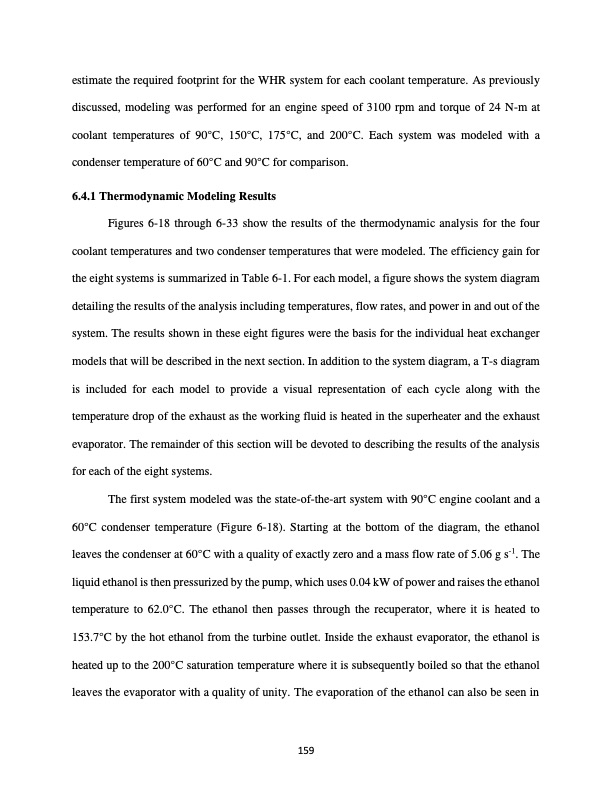
PDF Publication Title:
Text from PDF Page: 181
estimate the required footprint for the WHR system for each coolant temperature. As previously discussed, modeling was performed for an engine speed of 3100 rpm and torque of 24 N-m at coolant temperatures of 90°C, 150°C, 175°C, and 200°C. Each system was modeled with a condenser temperature of 60°C and 90°C for comparison. 6.4.1 Thermodynamic Modeling Results Figures 6-18 through 6-33 show the results of the thermodynamic analysis for the four coolant temperatures and two condenser temperatures that were modeled. The efficiency gain for the eight systems is summarized in Table 6-1. For each model, a figure shows the system diagram detailing the results of the analysis including temperatures, flow rates, and power in and out of the system. The results shown in these eight figures were the basis for the individual heat exchanger models that will be described in the next section. In addition to the system diagram, a T-s diagram is included for each model to provide a visual representation of each cycle along with the temperature drop of the exhaust as the working fluid is heated in the superheater and the exhaust evaporator. The remainder of this section will be devoted to describing the results of the analysis for each of the eight systems. The first system modeled was the state-of-the-art system with 90°C engine coolant and a 60°C condenser temperature (Figure 6-18). Starting at the bottom of the diagram, the ethanol leaves the condenser at 60°C with a quality of exactly zero and a mass flow rate of 5.06 g s-1. The liquid ethanol is then pressurized by the pump, which uses 0.04 kW of power and raises the ethanol temperature to 62.0°C. The ethanol then passes through the recuperator, where it is heated to 153.7°C by the hot ethanol from the turbine outlet. Inside the exhaust evaporator, the ethanol is heated up to the 200°C saturation temperature where it is subsequently boiled so that the ethanol leaves the evaporator with a quality of unity. The evaporation of the ethanol can also be seen in 159PDF Image | WASTE HEAT RECOVERY FROM A HIGH TEMPERATURE DIESEL ENGINE

PDF Search Title:
WASTE HEAT RECOVERY FROM A HIGH TEMPERATURE DIESEL ENGINEOriginal File Name Searched:
Adler_colostate_0053N_14539.pdfDIY PDF Search: Google It | Yahoo | Bing
NFT (Non Fungible Token): Buy our tech, design, development or system NFT and become part of our tech NFT network... More Info
IT XR Project Redstone NFT Available for Sale: NFT for high tech turbine design with one part 3D printed counter-rotating energy turbine. Be part of the future with this NFT. Can be bought and sold but only one design NFT exists. Royalties go to the developer (Infinity) to keep enhancing design and applications... More Info
Infinity Turbine IT XR Project Redstone Design: NFT for sale... NFT for high tech turbine design with one part 3D printed counter-rotating energy turbine. Includes all rights to this turbine design, including license for Fluid Handling Block I and II for the turbine assembly and housing. The NFT includes the blueprints (cad/cam), revenue streams, and all future development of the IT XR Project Redstone... More Info
Infinity Turbine ROT Radial Outflow Turbine 24 Design and Worldwide Rights: NFT for sale... NFT for the ROT 24 energy turbine. Be part of the future with this NFT. This design can be bought and sold but only one design NFT exists. You may manufacture the unit, or get the revenues from its sale from Infinity Turbine. Royalties go to the developer (Infinity) to keep enhancing design and applications... More Info
Infinity Supercritical CO2 10 Liter Extractor Design and Worldwide Rights: The Infinity Supercritical 10L CO2 extractor is for botanical oil extraction, which is rich in terpenes and can produce shelf ready full spectrum oil. With over 5 years of development, this industry leader mature extractor machine has been sold since 2015 and is part of many profitable businesses. The process can also be used for electrowinning, e-waste recycling, and lithium battery recycling, gold mining electronic wastes, precious metals. CO2 can also be used in a reverse fuel cell with nafion to make a gas-to-liquids fuel, such as methanol, ethanol and butanol or ethylene. Supercritical CO2 has also been used for treating nafion to make it more effective catalyst. This NFT is for the purchase of worldwide rights which includes the design. More Info
NFT (Non Fungible Token): Buy our tech, design, development or system NFT and become part of our tech NFT network... More Info
Infinity Turbine Products: Special for this month, any plans are $10,000 for complete Cad/Cam blueprints. License is for one build. Try before you buy a production license. May pay by Bitcoin or other Crypto. Products Page... More Info
| CONTACT TEL: 608-238-6001 Email: greg@infinityturbine.com | RSS | AMP |